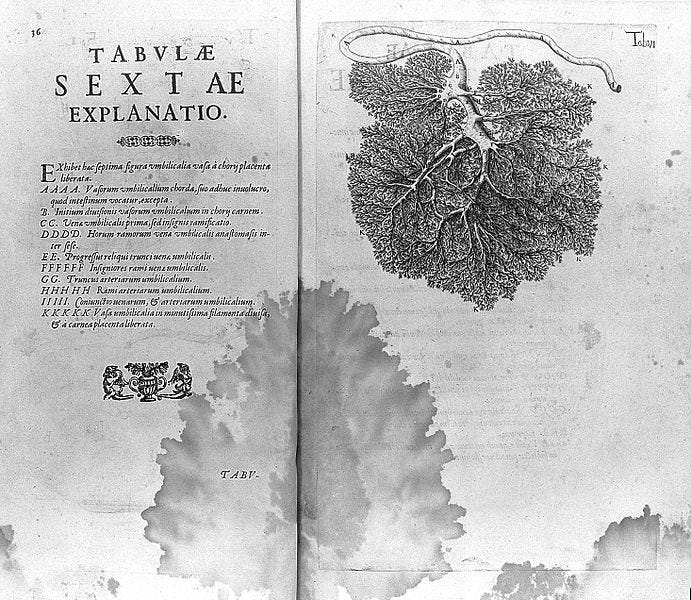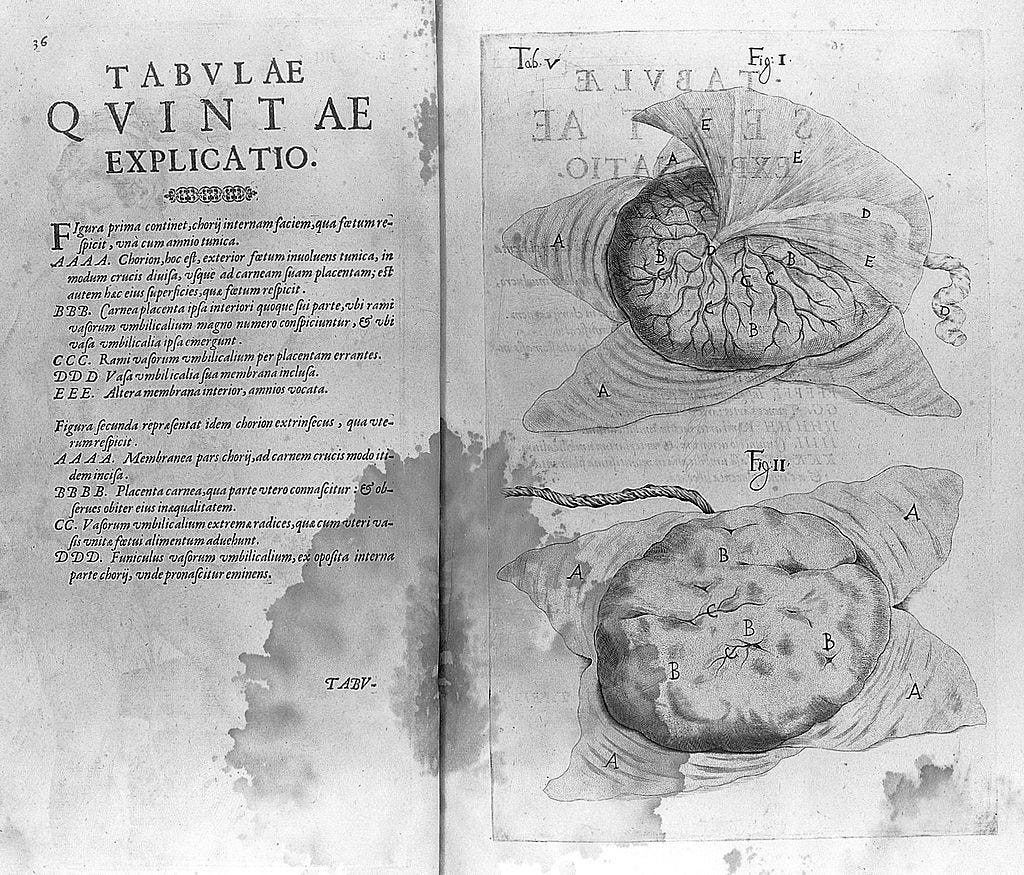UMBILICAL
I was born with the cord around my neck, which I considered pretty epic my whole life—born blue!—until I just read that it’s fairly common (20-30% of pregnancies) for babies to be entangled like this upon exit. It’s no big deal to go “nuchal” as it’s called, except the rare occasion when it is. I think I turned out well enough nonetheless.

Anyone born of a human knows that there’s a pretty heavy-grade cable connecting us to our mother’s bodies in utero, navel to placenta, until, typically the baby’s father gets handed the special scissors immediately after delivery (in the 1950s this was within seconds) to cut through this gristly feeding tube where nutrients and oxygen go into the fetus via veins and arteries and toxins are flushed out. There’s been debate for some years among the medical community about how long is optimal until the cutting. Consensus these days is it’s better to wait a little (minutes rather than seconds), until the blood flow slows, according to this article in the National Library of Medicine:
Those who support delayed cord cutting argue that for in term infants, the increased hemoglobin levels at birth improves iron stores in the first several months of life. This may have positive effects on developmental outcomes. In preterm infants, rates of intraventricular hemorrhage, and necrotizing enterocolitis are lower.
The World Health Organization recommends that the umbilical cord not be clamped earlier than 1 minute after birth in term or preterm newborns. The Royal College of Obstetricians and Gynecologists also recommends deferring umbilical cord clamping for healthy term and preterm infants for at least 2 minutes after birth. And most recently, in January 2017, the American College of Obstetricians and Gynecologists’ (ACOG) Committee on Obstetric Practice now recommends a delay in umbilical cord clamping in vigorous term and preterm infants for at least 30–60 seconds after birth. This ACOG guideline was also endorsed by The American Academy of Pediatrics. It was noted, however, that the ability to provide delayed umbilical cord clamping may vary among institutions and settings; decisions in those circumstances are best made by the team caring for the mother–infant dyad.
Ah the quaint mother-infant dyad, as if we’re squatting in a field. Rather, what most women in labor experience is anything but a dyad, as you have the stage crew of whatever loved ones and technicians and bleeping machines. As much as possible you can still try to deep-breathe into this dyad idea—sure it’s just you and your baby conjoined, getting through this ordeal as one, for now, until suddenly—snip. You are woefully separate and longing. My baby, where’s my baby, should they remove your newborn from you for a mere moment, the baby-need consumes you and your mammary glands. This inner ache to restore that private bond you carried for nine months will come and go as the child dips in and out of becoming more and less distinct from you until, one day, you are researching environmental college degrees upstate for your eldest and start to weep with sadness and joy during the YouTube promo with the drone footage soaring over the off-campus retreat site at the idyllic Adirondacks lake and the thought of Your Baby leaving at last.
These cords are complicated material, and their severing matters. Because I enjoy the salve of good medical terminology for our tough times, here’s more scholarly journal fare full of jargon but also moments of poetry about the anatomy of the cord:
The umbilical cord is a soft, tortuous cord with a smooth outer covering of amnion. It extends from the umbilicus of the fetus to the center of the placenta. Its length ranges from 50 cm to 60 cm, with a diameter of about 1 cm. The umbilical cord is composed of a gelatinous ground substance called Wharton's jelly or substantia gelatinea funiculi umbilicalis. It is composed of mucopolysaccharides from the conjugation of hyaluronic acid and chondroitin sulfate. As previously mentioned, three vessels comprise the umbilical cord: two umbilical arteries and one umbilical vein. It also encloses the urachus (a remnant of allantois). The urachus is a fibrous remnant of the allantois that extends through the umbilical cord and is located in the space of Retzius between the peritoneum posteriorly and the transverse fascia anteriorly. The urachus serves as a drainage canal for the urinary bladder of the fetus.
A soft, tortuous cord! And full of jelly like a powdered doughnut! Who is this Wharton? Thomas Wharton was an English anatomist who first described this goo in his 1656 publication Adenographia, which now in various articles, despite all our subsequent science, still gets referred to as “primordial,” “rich,” “concentrated,” “mysterious,” “enigmatic.”
The gnarly cord that resists separation at least doesn’t have nerves to detect its demise. Clamped in two places, the cord gets cut in between, volunteer’s teeth clenched with importance and effort. The omphalotomy is complete in the literal—if only ongoing metaphorically. Omphal(o) from the ancient Greek for navel, and -tomy for incision.
TECHNICAL
Google “cut the cord” and the first page of results aren’t medical but Cable. How to effectively break up with your Cable subscription. Never in my life have I had a Cable subscription and am stunned when I find anyone who still does. When I moved into this house that had black lines coming through the walls, I ripped them out and plugged the holes. Thanks to Other People’s Cable, I sure saw some things I shouldn’t have as a kid, and then as a teen babysitter, when I visited or worked for the neighbors. Horror movies and porn just there for the taking in the normal living rooms for all ages to access should you wander deep enough into the options with your clicker. And more essentially, the dawn of MTV.
On the rare chance I do sign up for a subscription as an adult with a mortgage and that looming kids-going-to-college concept, it’s because I need access to something specific and plan to extricate soon after. I’m forgetful yet organized enough to make sure I put the timeline of the free trial period on my calendar so I get an alert to end things before the surprise charge inevitably hits. I spreadsheet the heck out of everything, including an involved series of tabbed charts I made a few years ago (the companion piece to the salary goal I dared emblazon on my vision board) listing and sorting every expense I made over the course of an entire year. If I found anything superfluous that I didn’t absolutely need to live, I ruthlessly removed it, except maybe one streaming service (I’m partial to Netflix). I hate recurring costs so much, I bought an old Tesla with free supercharging for life so I wouldn’t have to buy gas, or electricity for that matter. I converted my house to 100% electric and then got solar panels to better approach my goal of net-zero. I buy next to nothing, and rarely anything new. I spreadsheeted my wardrobe and reduced it to a near-oblivion of staple capsule items that all match, removing most color and patterns and achieving closet nirvana, but that’s another neurotic story.
And as I only hinted at before but really actually did, I even put my dating life on a spreadsheet, as I armed myself with books, podcasts, and video research to hack my way to scientifically finding a love match... How’s that going? Well, to paraphrase my therapist, maybe it’s time to chill out. Temperature metaphors abound. Burnout is real. Everywhere I hear the lament that people are sick of the dating apps and want to get back to meeting people “in the wild,” yet they no longer even know how or where to begin.
For me, the starting point is to take back control of the apps that quickly control you, insidious as the real drug addiction that they provoke with their constant promise of dopamine. I just read that romantic rejection lights up the same regions of the brain as a heroin habit. You need another fast fix when a match soon goes south, a quick emergency replacement guy to chat to, anyone will do. I won’t do that anymore. I will not text with people I have no intention to meet. I won’t meet people I already know aren’t for me longterm. I haven’t gone as far as deleting or pausing the apps, but I will have the composure to look at them less, swipe less. Just swoop in sometimes for a fixed-time session and move along. The goal in general: care less, do less.
After enjoying a month of silence, I will build on the lessons learned: No longer allow myself to fall into the benumbed spell of social media scrolling, hyper-sleuthing a potential date’s backstory, or stalking the online activities of the Ghosts of Christmas Past. Detach. Turn off notifications, silent phone, hide apps from the homescreen, turn the device upside down or bury in the bottom of the backpack—whatever it takes to disengage. I keep repeating these mantras here because we all know this seemingly simple and obvious work of detox is hard.
Another thing I’m trying to cut: the crap. I mean: emojis, including 💩. I don’t use them here in my essay-writing and I don’t think I suffer being misunderstood, so why is it so damn scary not to soften many a sardonic text with a smiley face, a “ha,” or, somewhere deep in the rings of Hell, the desperate awkward outcry of an LOL. I’m decidedly not Laughing Out Loud when I have to write this to make sure someone, likely of low intellect, knows I’m joking. Scrubbed of the softening agent, if they don’t get it, they can ask. If they get offended, good riddance. I commit here to stopping the juvenile malarkey and letting the sharp words sting where they will.
MENTAL
Despite my quest to get my central air back online for the last few long hot weeks when its lack became pretty extreme, measured by sleeplessness and the decibels rising on kids’ complaining as we floated in what felt like simmering jello, I do not generally want or need frigid breezes blowing at me in the summertime. I don’t like going to work in thinner, skimpier clothes only to freeze under the industrial vents. I had to bring a sweater to see Inside Out 2. I’m not of hearty enough stock to survive an air-blasted summer indoors in, say, Florida or Texas. I would be the overly tan lady outside, ejected out of my frigid Florida air-con house into the record-breaking heat to bask like a drying lizard. And I might love it or die trying.
Global warming and all, July is my month, along with the ripe raspberries. It’s my birth month. Summer baby. Cancer crab. Thick of shell and muddled red jelly within. Despite my Home|body tendencies, this is the season when I feel healthiest, most like myself, most active, most independent from my house/shell. Happiest. Maybe it’s as simple as a needed boost of vitamin D, but I believe there’s more than that. The heat blast forces me to slow down in certain ways but speed up in others: less stress, more extracurriculars. The relentless manual upkeep my rural outpost requires keeps me fit and strong. I can take more, longer runs before or after work when the sun is slant, explore every local forest trail. Dunk myself in any available body of water.
I retreat to the country where my phone and wifi can’t follow to relax with the work I like most and, sometimes, to witch.
When my boyfriend of nearly two years dumped me after giving me a good 50th birthday sendoff, I would escape to my Catskills trailer, in the land where the mythic mountain magic happens and Rip Van Winkle slept 20 years through the Revolution (my RV’s last name is Winkle), to lick my wounds. One day I felt compelled to try to bid him adieu by building a giant wet bonfire on his behalf. “This is my Matt pile, and I’m going to burn it down,” I found myself repeating as I struggled for a few weekend visits to remove all evidence of this massive tangle of thorny bramble I had dug out from all over the property and filled a large basement foundation hole. Still after this surge-purge the loss of him hits me unawares. And that’s ok—sometimes multiple attempts at this are required, says the chick lit. A new ceremony is in order. This time a legit cord-cutting.
Lately I had amassed even more worth burning—not bramble but more bad mojo, more clinging to objects/ideas/people/stories that don’t serve me, that deplete my power and distract me from being present. I ripped a sheet of blank paper into a bunch of smaller pieces. I brought a long cord and a pair of scissors and instructions I actually printed out with a script for a proper cord-cutting. On each piece, I wrote a name or intangible thing I wanted to release. My dead dad’s narcissism, my estranged brother’s silence, my mother’s brainwashed politics, the ancient actions 34 years ago of my date-rapist, these ever-haunting exes, then the dudes of no consequence who give me scant attention, and pieces just for that: attention, attachment. To each piece, I cut a little cord and said a statement bidding them adieu and why it was time to let go their hold. The pile of these ripped papers with names and their little cords proceeded with me to the dreaded firepit, where again, and more easily this time, I burned it down.
The thing about cutting, besides how you may have to keep on cutting, is how it immediately clears space for other better things to enter. I felt emptied and open, and then suddenly there was all this silence and time and space (without the white noise of screens, texts, and the disembodied) to make playdates with new girlfriends, go on more hikes, attend the Thirsty Thursday backyard parties in my village with neighbors, go see an improv troupe, witness our first on- and off-land Mermaid Parade, learn how to self-publish a book (born the other day!), brainstorm starting a local flea market.
There’s a timely documentary out called Join or Die about the grim fate of America when our networks are broken, the social capital bankrupt. We face a plague of loneliness, civic infrastructure in ruin, quoting heavily from Bowling Alone author Robert Putnam. We can despair or repair. Disconnecting from too-much-tech doesn’t mean stop paying attention, because as you know if you watched any of the dreadful circus of the RNC, characters like Hulk Hogan and Kid Rock or JD Vance will happily come fill that void with 💩 if you don’t have anything better going on. If a club doesn’t exist that you want to join, then form one. (And humor me that one last emoji as there are no words.)
I have plans. This baby emerging below looks like the center of a flower, the placenta its roots.








I sure like these weekly visits (which means, your writing). Decided I need to disengage, myself, from my own cord - habitual politics chasing - after a bit of a meltdown (I don't even know *what* to say about the times we're living in, only that it will change). I can still take as much political action as I was planning before without going to the 3-4 websites/blogs/substacks I've been obsessively (I'm realizing) chasing down and rolling in like a dog in carrion (not 100% with this metaphor; I mean, dogs *like* this stuff). Again, I'm STILL taking action, while taking myself a bit out of the action. Who knows, I'll probably be more efficient this way. But it's necessary as my brain and emotions had gotten away from me (like dogs broken from the leash? But it also feels like monkey mind, which is accurate too, but different. Feels like a mixed metaphor combo of both, actually) (And I know I know people say that parenthetical comments weaken your writing, or, heaven forbid, make *you* appear weaker, but I don't buy that, and really, I don't care. I enjoy them, like some people enjoy emoticons 😉) (actually, I enjoy emoticons too, but not as a cheap clarifier for the intent of my writing; my writing should be clear enough on its own 🙂 ) (What was I saying? Who cares?)
P.S. I was a forceps baby. Can't remember the rest of the story and I'd ask my mom for clarification but she's traversing the universe and the time/space continuum now. Surf it, Mom! For many years she was convinced this was why I've been near-sighted since grade school - the squeeze elongated my eyeballs and caused this. I finally asked her to stop - I never liked hearing it - and that a recessive gene was about a million times more likely.
Wow! This was exceptional and powerful and evocative writing. Brilliantly done. And my first daughter was an emergency C-section when the cord wrapped around her neck. One second I was in the attached bathroom, the next I stepped out and saw furniture flung to the far walls as teams of people rushed the mother of my children to the operating room. Scary! But all turned out okay.
PS. There is some one out there for you who deserves you. Keep the faith!